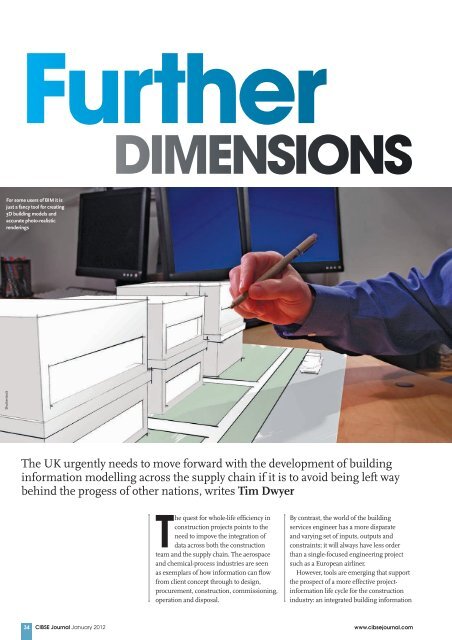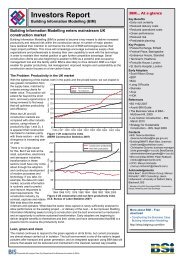Further Dimensions - BIM Task Group
Further Dimensions - BIM Task Group
Further Dimensions - BIM Task Group
You also want an ePaper? Increase the reach of your titles
YUMPU automatically turns print PDFs into web optimized ePapers that Google loves.
<strong>Further</strong>dimensionsFor some users of <strong>BIM</strong> it isjust a fancy tool for creating3D building models andaccurate photo-realisticrenderingsShutterstockThe UK urgently needs to move forward with the development of buildinginformation modelling across the supply chain if it is to avoid being left waybehind the progess of other nations, writes Tim DwyerThe quest for whole-life efficiency inconstruction projects points to theneed to impove the integration ofdata across both the constructionteam and the supply chain. The aerospaceand chemical-process industries are seenas exemplars of how information can flowfrom client concept through to design,procurement, construction, commissioning,operation and disposal.By contrast, the world of the buildingservices engineer has a more disparateand varying set of inputs, outputs andconstraints; it will always have less orderthan a single-focused engineering projectsuch as a European airliner.However, tools are emerging that supportthe prospect of a more effective projectinformationlife cycle for the constructionindustry: an integrated building information34CIBSE Journal January 2012www.cibsejournal.com
IT & SOFTWARE 1 BUILDING INFORMATION MODELLINGmodel, which can be exploited and developedby the whole construction team and enablescontractors and building operators to getearlier involvement in the process. Thisrequires appropriate contributions fromrelevant parties throughout all stages of theproject delivery. Construction and facilitiesmanagement (FM) organisations also needto be involved earlier in a more integratedfashion than most traditional procurementprocesses permit.Building informationmodelling (<strong>BIM</strong>) is seenby some as a simple‘add-on’ to a 3D design toprovide a data trove forsubsequent interrogationand manipulation.For others it is just afancy tool for creating3D building modelsand accurate photorealisticrenderings.But <strong>BIM</strong> should be seen as a process andan enabler, a catalyst for truly integratedworking in a collaborative design and supplychain between all the stakeholders in aconstruction project.In an ideal project <strong>BIM</strong> underlies aproject from conception through design,manufacture and construction, to life-longoperation and eventual decommissioning,demolition and recycling. But this is aworld away from the ‘lonely <strong>BIM</strong>’ that existsin many of today’s disparate individualapplications.DifferentiatorBy proper integration into businessmethods, <strong>BIM</strong> has the potential to speed updecision-making and remove unnecessaryprocesses that don’t add value – improvingthe cost-effectiveness of the constructionprocess and increasing industry profitability.But the push for <strong>BIM</strong> by some clients,architectural and engineering firms, andforward-looking contractors can mean thatother project members are chasing to catchup with <strong>BIM</strong> competencies so that they canwork meaningfully – or, in some cases, sothat they can work at all.<strong>BIM</strong> is appearing as a differentiatorbetween organisations in the supply chain.Sometimes, however, the result is marketingpuff – or ‘<strong>BIM</strong>wash’ – rather than the realthing.What is clear is that <strong>BIM</strong> cannot bean exclusive tool and still deliver thewide-ranging benefits that clients areincreasingly seeking. <strong>BIM</strong> will drive thewhole construction chain towards reviewingand updating its processes and technology,as well as its methods of collaborationwith its project partners. <strong>BIM</strong> presents anew opportunity for the whole industryto embrace and reap mutual benefits, butunlike the move from drawing boards toCAD seen over the last generation, <strong>BIM</strong>truly requires a paradigm shift.It will prove a challenging task to try todirectly map <strong>BIM</strong>in terms of specificIdeally <strong>BIM</strong> shouldunderlie a project fromconception, design,manufacture andconstruction to life-longoperation and eventualdecommissioning,strip-out and recyclingreturn on investmentor productivitygains. But <strong>BIM</strong> is aglobal phenomenon,potentially providingopportunities innew markets. Earlyadopters of <strong>BIM</strong> canhelp others in theconstruction sectorto get on board;and there is a vital role to be played by theindustry’s institutions and associations tohelp their members get up to speed withthe process.Re-skillingIncreasingly there is a need for <strong>BIM</strong>capability within projects. But real <strong>BIM</strong>is not a simple add-on to the skill-set ofexisting building professionals: it requiressignificant investment in ‘retooling’ theteams with methods, skills and resources.Many larger contractors have seenthemselves as bearing the brunt of earlydevelopment costs. After the initial businesscosts, it is estimated that it costs around£12,000 per ‘<strong>BIM</strong>-enabled engineer’ forthe software, training, set-up and supportneeded. This may be seen as a ‘showstopper’, especially for small businesses, butthe real contention is that this is an upfrontinvestment, not only to gain work, but alsoto unlock efficiencies of <strong>BIM</strong> workflows.And the training need not stop there: <strong>BIM</strong>will require new ways of working, andtherefore training is needed in the newprocesses and attitudes – at all levels of theindustry – to successfully adopt <strong>BIM</strong>.To move forward there needs to be atop-down commitment by industry to reskillthe workforce, together with a can-doattitude from those developing and usingthe technology and processes at the grassroots. <strong>BIM</strong> will not thrive with small pocketsof CAD users or engineers getting excitedand trying to justify business cases driven byglamorous software purchases.Unfolding of <strong>BIM</strong>‘roadmap’In September 2009 the Departmentof Business Innovation and Skillscommissioned an industry workinggroup to provide a report on thepotential future use of <strong>BIM</strong>.The Government ConstructionClients board adopted the workinggroup and agreed to receive itsfinal report, which was presented inMarch 2011.The report sets out a suggestedroadmap and strategy to enablethe progressive use of <strong>BIM</strong> ongovernment building programmes,as well as providing a frameworkfor procurement and deliverystandards.The report also considers thetraining and support required toenable the industry to rise to the<strong>BIM</strong> challenge.The Government ConstructionStrategy, published by the Cabinetoffice on 31 May 2011, sets out thegovernment’s intention to requirecollaborative 3D <strong>BIM</strong> with fullydigital data by 2016.l To download the full <strong>BIM</strong> reportgo to http://goo.gl/acAC8www.cibsejournal.comJanuary 2012 CIBSE Journal 35
IT & SOFTWARE 1 BUILDING INFORMATION MODELLINGArup Associatesmeasure the real benefits. A reportcommissioned by the Department forBusiness in 2008 to look at the benefits of<strong>BIM</strong> suggested that the net benefit of <strong>BIM</strong>to the UK, if extended to all major projects,would account for between £1bn and £2.5bna year in the construction phase alone –the benefits in the operational life of thebuilding are additional to this.This is a criticalperiod. Some anticipatethat unless <strong>BIM</strong> is fullyintegrated into the UKconstruction processwithin very few years,much of the industrywill be left behindinternational competitors.The government isalready seeking efficiencytargets of 20% for the whole life of its assetsthrough the adoption of <strong>BIM</strong>. This is seenas a realistic overall target if the industry isequipped with appropriate competencies.But, because <strong>BIM</strong> is a ‘front-loaded’process, M&E consultancies are likely tofind that some of the work traditionallyundertaken at later stages (for example,defining specific equipment duringtendering and procurement) will requiremore detailed input earlier in the designprocess. Although this will result indownstream efficiencies – with lessuncertainties, site alterations and ‘requestsfor information’ – there needs to be someredistribution of project professionalfees to reflect the changing roles andresponsibilities that occur in a <strong>BIM</strong> projectcompared with a traditional contract process.The development of <strong>BIM</strong> standardsand protocols cannot be dominated by asingle sector, professional institution orrepresentative body. Instead they shouldemerge from atrue cross-industryGovernmentprocurement mustalso be accompaniedby clear advice on how<strong>BIM</strong> will affect roles,responsibilities, risk andreward in constructiondiscussion.Leadership mustbe provided fromthe top down, frompublic and privatesector clients, frominstitutions, andfrom leading-edgeorganisations.The author thanks the following fortheir help with the article, which does notnecessarily represent their views: CIBSE<strong>BIM</strong> <strong>Group</strong> and George Adams (SpieMatthew Hall), Peter Kinsella (AE Smith& Son Pty Ltd), David Churcher (BSRIA),Gary Ross (Capita Symonds), Carl Collins,Dan Clipsom and Colin Magner (Arup), andPaddy Conaghan, Andy Hill and RichardVincent (Hoare Lea).Professor Tim Dwyer is a teaching fellow atUniversity College London and technical editor ofCIBSE Journal www.timdwyer.comIn an ideal world, <strong>BIM</strong>would be more than multidimensionalrendering – itwould be a catalyst for trulyintegrated working in acollaborative design andsupply chainWhat is your experience of <strong>BIM</strong>?CIBSE has set up a <strong>BIM</strong> working groupthat includes consultants, manufacturers,contractors, software producers and keyindustry associations to ensure that theinterests of the building services communityare identified, and solutions moved forwardthat provide the industry with unitedmethods and standards.What is your experience and opinionof how CIBSE and the industry should bemoving forward with <strong>BIM</strong> to aid your sectorof the industry – let us know in the very briefsurvey at http://goo.gl/W5lb8www.cibsejournal.comJanuary 2012 CIBSE Journal 37
















